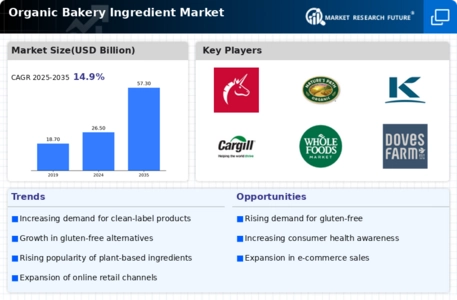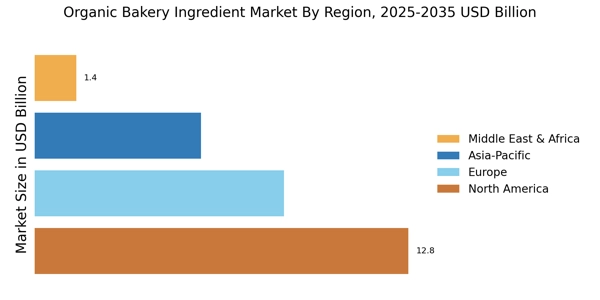Diverse Dietary Needs
The Organic Bakery Ingredient Market is also being propelled by the increasing diversity of dietary needs among consumers. With the rise of various dietary preferences, such as gluten-free, vegan, and paleo diets, there is a growing demand for organic ingredients that cater to these specific requirements. Market data suggests that the gluten-free segment alone has seen substantial growth, with many consumers seeking organic alternatives to traditional bakery products. This diversification in consumer preferences indicates that the Organic Bakery Ingredient Market must adapt to meet the evolving needs of its customer base. As more individuals seek out products that align with their dietary restrictions, the market for organic bakery ingredients is poised for continued expansion.
Health-Conscious Consumerism
The Organic Bakery Ingredient Market is experiencing a notable surge due to the increasing health-consciousness among consumers. As individuals become more aware of the nutritional value of their food, there is a growing preference for organic ingredients that are perceived as healthier alternatives. This trend is reflected in market data, which indicates that the organic food sector has been expanding at a compound annual growth rate of approximately 10%. Consumers are actively seeking products that are free from artificial additives and preservatives, which further drives the demand for organic bakery ingredients. This shift in consumer behavior suggests that the Organic Bakery Ingredient Market is likely to continue its upward trajectory as more people prioritize health and wellness in their dietary choices.
Regulatory Support and Standards
Regulatory frameworks and standards play a significant role in shaping the Organic Bakery Ingredient Market. Governments around the world are implementing stricter regulations regarding food safety and organic certification, which can enhance consumer trust in organic products. This regulatory support is crucial for the growth of the organic sector, as it ensures that products meet specific quality and safety standards. Market data indicates that regions with robust regulatory frameworks tend to have higher consumer confidence in organic products, leading to increased sales. As the Organic Bakery Ingredient Market continues to evolve, the presence of clear regulations and standards will likely foster a more transparent and trustworthy marketplace, encouraging further growth in consumer demand for organic bakery ingredients.
Innovation in Product Development
Innovation plays a crucial role in the Organic Bakery Ingredient Market, as manufacturers strive to create new and exciting products that meet consumer demands. The introduction of novel organic ingredients, such as alternative flours and natural sweeteners, has the potential to attract a broader audience. Market trends indicate that consumers are increasingly interested in unique flavors and textures, which encourages companies to experiment with their product offerings. This focus on innovation not only enhances the appeal of organic bakery products but also positions the Organic Bakery Ingredient Market as a dynamic sector capable of adapting to changing consumer preferences. As companies invest in research and development, the market is likely to witness a wave of new products that cater to diverse tastes.
Sustainability and Ethical Sourcing
Sustainability has emerged as a pivotal driver in the Organic Bakery Ingredient Market. Consumers are increasingly concerned about the environmental impact of their food choices, leading to a preference for ingredients that are sustainably sourced. This trend is supported by data indicating that a significant percentage of consumers are willing to pay a premium for products that align with their values regarding environmental stewardship. The organic certification process often includes stringent guidelines for sustainable farming practices, which appeals to eco-conscious consumers. As a result, the demand for organic bakery ingredients that are produced with minimal environmental impact is likely to grow, positioning the Organic Bakery Ingredient Market favorably in a market that values sustainability.


















Leave a Comment